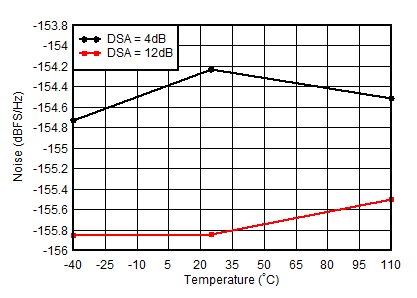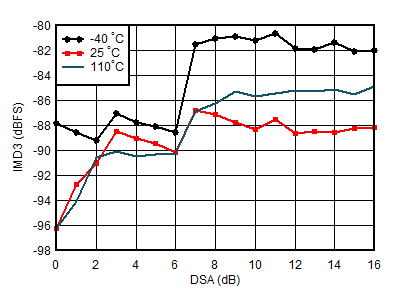Typical values at TA = +25°C, ADC
Sampling Rate = 2949.12 GHz. Default conditions: output sample rate = 491.52 MSPS
(decimate by 6), PLL clock mode with fREF = 491.52 MHz, AIN =
–3 dBFS, DSA setting = 4 dB.

| With
0.8 GHz matching, normalized to 830 MHz |
|
Figure 5-285 RX
In-Band Gain Flatness for Channel 1RX, fIN = 830 MHz
| With
0.8 GHz matching, normalized to phase at 25°C |
|
Figure 5-287 RX
Input Phase vs Temperature and DSA at fOUT = 0.8 GHz
| With
0.8 GHz matching |
| Differential Amplitude Error = PIN(DSA
Setting – 1) – PIN(DSA Setting) + 1 |
Figure 5-289 RX
Calibrated Differential Amplitude Error vs DSA Setting at 0.8 GHz
| With
0.8 GHz matching |
| Integrated Amplitude Error = PIN(DSA
Setting) – PIN(DSA Setting = 0) + (DSA
Setting) |
Figure 5-291 RX
Calibrated Integrated Amplitude Error vs DSA Setting at 2.6 GHz
| With
0.8 GHz matching |
| Differential Phase Error = PhaseIN(DSA
Setting – 1) – PhaseIN(DSA Setting) |
Figure 5-293 RX
Calibrated Differential Phase Error vs DSA Setting at 0.8 GHz
| With
0.8 GHz matching |
| Integrated Phase Error = Phase(DSA Setting) – Phase(DSA
Setting = 0) |
Figure 5-295 RX
Calibrated Integrated Phase Error vs DSA Setting at 0.8 GHz
| With
0.8 GHz matching, 12.5-MHz offset from tone |
Figure 5-297 RX
Noise Spectral Density vs Temperature at 0.8 GHz
| With
0.8 GHz matching, 12.5-MHz offset from tone |
|
Figure 5-299 RX
Noise Spectral Density vs Input Amplitude and Channel at 0.8 GHz
| With
0.8 GHz matching, each tone –7 dBFS, tone spacing = 20
MHz |
Figure 5-301 RX
IMD5 vs DSA Setting and Temperature at 0.8 GHz
| With
0.8 GHz matching, tone spacing = 20 MHz, DSA = 12
dB |
Figure 5-303 RX
IMD3 vs Input Level and Temperature at 0.8 GHz
| With
0.8 GHz matching, measured after HD2 trim, DDC bypass
mode (TI only mode for characterization) |
Figure 5-305 RX
HD2 vs DSA Setting and Channel at 0.8 GHz
| With
0.8 GHz matching, measured after HD2 trim, DDC bypass
mode (TI only mode for characterization) |
Figure 5-307 RX
HD2 vs Input Level and Temperature at 0.8 GHz
| With
0.8 GHz matching, DDC bypass mode (TI only mode for
characterization) |
Figure 5-309 RX
HD3 vs DSA Setting and Temperature at 0.8 GHz
| With
0.8 GHz matching, DDC bypass mode (TI only mode for
characterization) |
Figure 5-311 RX
HD3 vs Input Level and Temperature at 0.8 GHz
| With
0.8 GHz matching, –7 dBFS each tone, 20-MHz tone
spacing, all supplies at MIN, TYP, or MAX recommended
operating voltages |
Figure 5-313 RX
IMD3 vs Supply and Channel at 0.8 GHz
| With
0.8 GHz matching, 12.5-MHz offset, all supplies at MIN,
TYP, or MAX recommended operating voltages |
Figure 5-315 RX
Noise Spectral Density vs Supply and Channel at 0.8 GHz
| With
0.8 GHz matching, normalized to fullscale at 25°C for
each channel |
Figure 5-286 RX
Input Fullscale vs Temperature and Channel at 800 MHz
| With
0.8 GHz matching |
| Differential Amplitude Error = PIN(DSA
Setting – 1) – PIN(DSA Setting) + 1 |
Figure 5-288 RX
Uncalibrated Differential Amplitude Error vs DSA Setting at 0.8 GHz
| With
0.8 GHz matching |
| Integrated Amplitude Error = PIN(DSA
Setting) – PIN(DSA Setting = 0) + (DSA
Setting) |
Figure 5-290 RX
Uncalibrated Integrated Amplitude Error vs DSA Setting at 0.8 GHz
| With
0.8 GHz matching |
| Differential Phase Error = PhaseIN(DSA
Setting – 1) – PhaseIN(DSA Setting) |
Figure 5-292 RX
Uncalibrated Differential Phase Error vs DSA Setting at 0.8 GHz
| With
0.8 GHz matching |
| Integrated Phase Error = Phase(DSA Setting) – Phase(DSA
Setting = 0) |
Figure 5-294 RX
Uncalibrated Integrated Phase Error vs DSA Setting at 0.8 GHz
| With
0.8 GHz matching, fIN = 840 MHz,
AIN= –3 dBFS |
Figure 5-296 RX
Output FFT at 0.8 GHz
| With
0.8 GHz matching, DSA Setting = 12 dB, 12.5-MHz offset
from tone |
Figure 5-298 RX
Noise Spectral Density vs Input Amplitude and Temperature at 0.8 GHz
A.
| With
0.8 GHz matching, each tone –7 dBFS, tone spacing = 20
MHz |
Figure 5-300 RX
IMD3 vs DSA Setting and Temperature at 0.8 GHz
| With
0.8 GHz matching, tone spacing = 20 MHz, DSA = 4
dB |
Figure 5-302 RX
IMD3 vs Input Level and Temperature at 0.8 GHz
| With
0.8 GHz matching, tone spacing = 20 MHz, DSA = 12
dB |
Figure 5-304 RX
IMD5 vs Input Level and Temperature at 0.8 GHz
| With
0.8 GHz matching, measured after HD2 trim, DDC bypass
mode (TI only mode for characterization) |
Figure 5-306 RX
HD2 vs DSA Setting and Temperature at 0.8 GHz
| With
0.8 GHz matching, DDC bypass mode (TI only mode for
characterization) |
Figure 5-308 RX
HD3 vs DSA Setting and Channel at 0.8 GHz
| With
0.8 GHz matching, DDC bypass mode (TI only mode for
characterization) |
Figure 5-310 RX
HD3 vs Input Level and Channel at 0.8 GHz Figure 5-312 RX
Non-HD2/3 vs DSA Setting at 0.8 GHz
Figure 5-312 RX
Non-HD2/3 vs DSA Setting at 0.8 GHz
| With
0.8 GHz matching, –7 dBFS each tone, 20-MHz tone
spacing, all supplies at MIN, TYP, or MAX recommended
operating voltages |
Figure 5-314 RX
IMD5 vs Supply and Channel at 0.8 GHz





























